June 2019
What We’ll Remember From Zambia
Welcoming Smiles, Wonderful Colors, Bad Roads, Great Waterfalls
It always starts with people. Faces seen along the roadway; men and women working, carrying, buying, selling, chatting and laughing with each other. Children running and playing, but also taking care of each other, with older ones holding younger ones’ hand or carrying infants, and also working: carrying water and firewood, or small bundles from the market. People of all ages who turn to watch us passing by; the look on their faces asking who are these people and why have they come here. Sometimes they wave at us first and sometimes we wave and smile first and they respond in kind. Best of all are the ones whose expression as we approach seems hopeful, seeming to ask to be seen, noticed, acknowledged; and then when we do see them and wave to them their faces just explode with delight; laughter and joy and wildly waving hands. Acceptance, welcome, friendliness, connection; all contained in a smile and a wave.
Driving past them all we often wonder about what they must be thinking. We are clearly so very different from them as to be nearly incomprehensible. They are black, we are white; to them we are wealthy, while by any western standard they are poor; they will probably never leave their own country while they can easily see that we have visited many; they must work everyday their entire lives in order to contribute to their family’s livelihood, while we are ‘retired’ — a state of being totally foreign to their experience. And yet… we see it in their faces, in the things they are doing, in their interactions with each other, and most especially in the care they take with their children. We are not different at all; we are the same. We are people too; all of us.
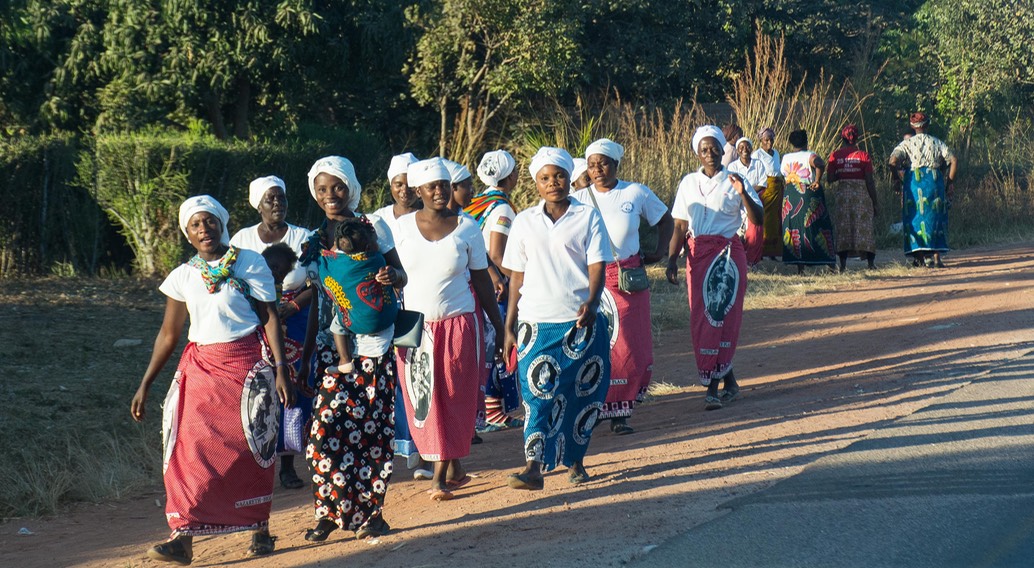
None of these observations are unique to our experience in Zambia; we’ve seen the same sorts of things in each country we’ve visited, here in Africa and elsewhere. Maybe it is just starting to sink in more, or perhaps these things stood out in bolder relief in this country and at this time in our own lives. Who can say?
Crossing the border from Namibia, we had a list of places in Zambia that we wanted to see, and a bunch of waterfalls were high on the list — Zambia has many rivers and many falls. But first we had to negotiate a tedious border crossing. We’d been warned there might be difficulties and there were some; not too bad, but not the easiest crossing we’ve ever had. It took several hours, and was a bit of a mess on lots of fronts, but nothing extraordinary. The experience reminded us of two things: don’t come through on the weekend; and don’t come through over the lunch hour(s). We’ll see later if what transpired was all just fine, or if the (apparently) poorly trained staff that processed us even knew what they were doing. But here we were in Zambia, our first country in Africa that was outside the South African Customs Union, and we were jazzed. We had places to visit, new money to mess about with, and a whole new set of people to learn from and about. And right off, we liked the people.
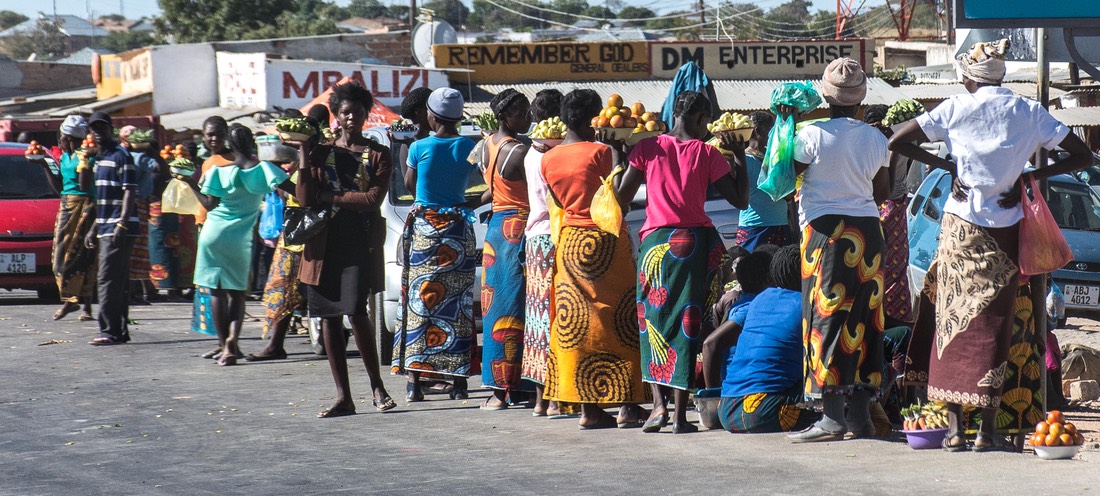
Zambia, like much of where we’re visiting in Africa, is very poor, with low life expectancy, lots of AIDS problems, tortured (i.e., denuded) countryside, and to a major degree subsisting on tourism. But we are finding that the people are cheerful, stand up straight, work hard to support themselves, and seem to be very close as families, with many women walking along carrying not only loads of grain or firewood on their heads, but also babies wrapped up on their backs.
Leaving the border we got to Sesheke, the first town we’d come to in Zambia, and a mere half dozen kilometers down the road. It was later than we’d hoped and we headed straight for a spot we’d picked out — Brenda’s Best Baobab Lodge and Camping (great name, and quite apt). We had trouble finding it, stopping first at what we thought was the right place, only to be told this was a restaurant where a party was just starting up. Oops, we don’t need all that noise! So we tried a couple of other spots, to no avail. One was the local police station, to see if we could stay there, but it was getting on toward Saturday night, and they were very busy dealing with drunks and the walking wounded. We hadn’t realized how typically “border town” Sesheke actually was!
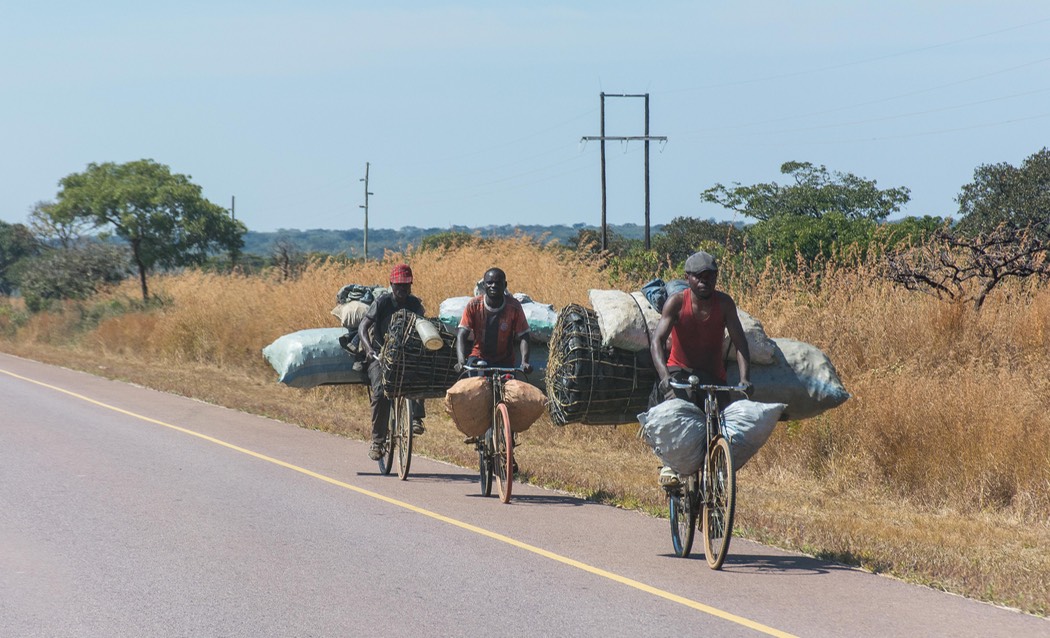
Finally finding Brenda’s, we were quite happy to settle in for the night. It turned out to be very near the restaurant where we’d first stopped, but somehow we’d missed the sign. The facility is right on the Zambezi River, and has a garden full of tropical foliage, all in full bloom… Oh, and yes, indeed, one humongous baobab to enjoy. The music from the party next door didn’t keep us from a good night’s sleep; it stopped at about 3:00 am.
I had a nice walk of the property with the owner, who showed me where the river usually came up to this time of year — far higher than what we were looking at now. Much of southern Africa has had a very bad year for rain, and many rivers and lakes are very low. We will be checking out Victoria Falls while in Zambia, and have been told that the water coming over the falls is still quite impressive, but “nothing like” usual at this time.
The next day we drove east to Livingstone, where we were planning to stay for a few days while we visited Vic Falls and got organized for this new country. Driving through the countryside, we could see how dry it already was. And, as promised by other travelers, once you go about 35 kms east of Sesheke, the road turns bad, adding in these amazing potholes that you must maneuver around. This lasts forever it seems (actually only about 100 kms), before turning into a decent tar road the rest of the way into Livingstone. Rather sad. And the ubiquitous police are right there to make sure you aren’t speeding/crossing solid lines/missing stop signs… speed traps. So! Our introduction to Zambia.
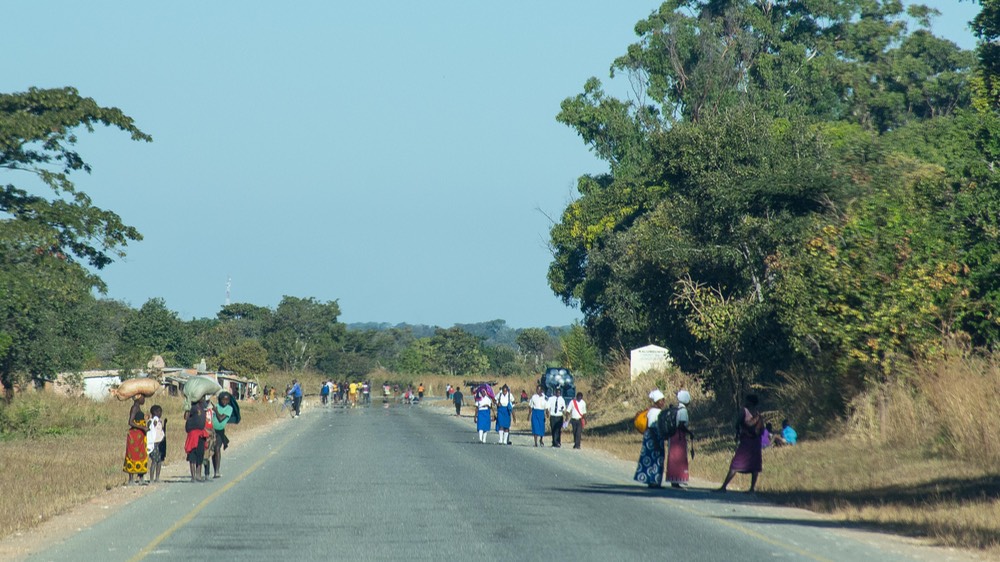
As we drive along, people are a regular presence along the road, as is true throughout the region. Mostly walking, some on bicycles, and in the far northern part of the country, close to the Tanzanian border, a few on motorbikes. All this is joined by the occasional cart with cows pulling the load (we saw no donkeys in Zambia). They were happy to respond to our cheerful waves and called out “hellos”, and most often broke into huge grins.
All this was regularly joined by (mostly) women selling produce. At good prices and for good value, we might add. It was toward the end of the growing season, and fruit and veggies were always available, and in many areas sugar cane as well. Quite productive. We were off to a good start here.
Zambia doesn’t get a lot of attention from most travelers, even overlanders. Mostly, folks take a pretty direct route through, spending 2-3 weeks at the most, stopping at the major attractions. In part this is because the road network is pretty limited. Basically, from the capital city of Lusaka you must choose either to go east to Malawi or north to Tanzania without a lot of options for connecting up to other roads once you’ve left the capital. We’ll have more on this later. One result of the limited road choices is that Zambia is treated by many as a corridor to get further north. It is bordered by no fewer than eight other countries: the Democratic Republic of Congo, Tanzania, Malawi, Mozambique, Zimbabwe, Botswana, Namibia and Angola; with most overland travelers passing through going from either Botswana, Namibia or Zimbabwe on to either Malawi or, usually, Tanzania.
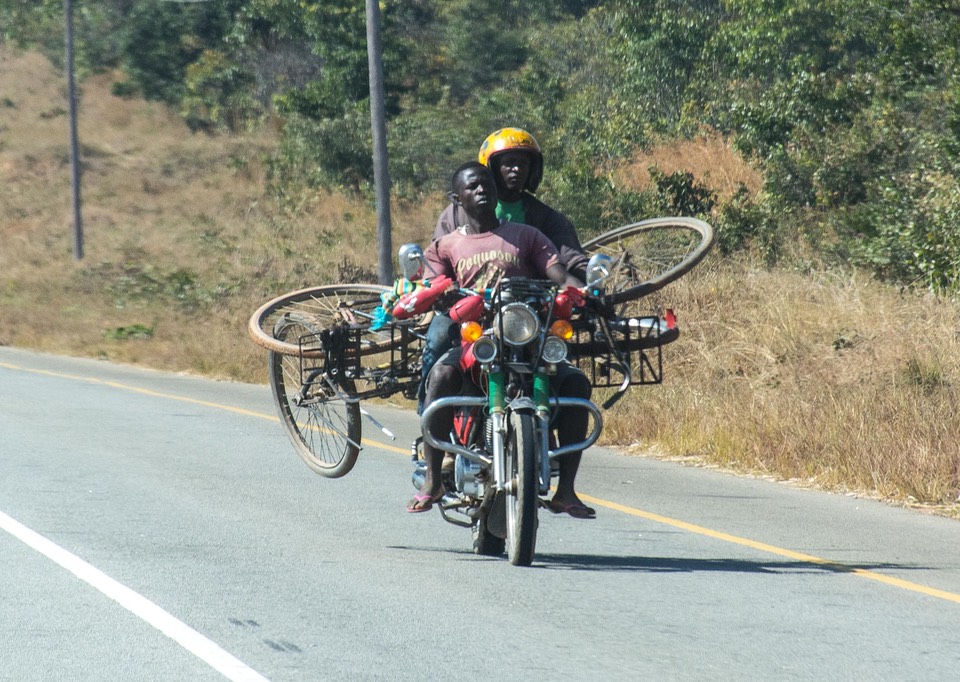
In chatting with the manager of a lodge we stayed at along our journey, she commented that people complain that driving along there isn’t much of interest to see from the road — just shrubbery and the occasional tree. We decided that this was, at least in part, because much of the countryside has been denuded of trees in order to provide firewood in one way or another. About 30 percent of the country is now set aside and protected, and we have seen some reforestation projects underway.
In the same vein, you don’t see many wild animals in Zambia. They used to be here, but extensive uncontrolled poaching “denuded” the land of critters as well. I’ve spent some time reading through an old guidebook to Zambia, published in 1999. It’s very good, and offered a lot of insights into the situation here.
Apparently there were once vast herds of elephants and rhino but the early years of the 19th century saw them almost totally destroyed for the ivory and horns. Through belated protection, by 1970 they had built the herds up again; then automatic rifles were introduced and, with governmental changes, the protections stopped. Within a decade they were destroyed again; in 1999 perhaps a total of 25,000 remained. Today, in 2019? We understand there are some in the game parks, but that’s about it.
Positives, however, include smiling people who are happy to see us; lots of bicycles along the roadbeds; charcoal-making facilities along the roadways and large bags of the finished products available for sale just about every place you look. Interestingly, as we enter the country it’s almost entirely men we are seeing on those bikes; the women are walking along, large loads balanced on their heads and children balanced on their hips or dangling out of tied cloth on their backs. (As we get further into exploring Zambia, we have now seen women riding bikes as well. Editorially speaking, they look so very happy and free!)
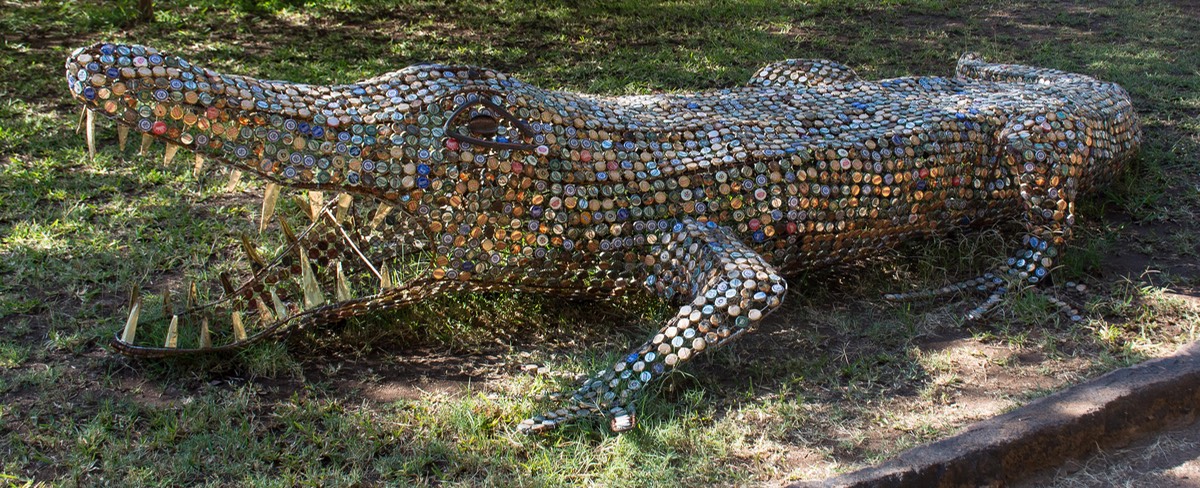
Yes, we survived the road to Livingstone, getting ourselves settled in a charming guest house, the Thorn Tree House south of town, down along the road to the Falls. It’s a small setup, with chalets, tents and open parking and grassy areas for those of us who bring our homes with us. It’s within the boundaries of the national park, so there are critters to be looked out for: crocodiles and elephants are the main subject of conversation. We were delighted to be here. The owner helped us figure out how to most easily see the Falls on the Zambian side, as well as offering anything else she could do for us. Someone had made several splendid and very lifelike sculptures of some of the local wildlife — iguanas, crocodiles, elephants, rhinos — out of bottle caps. They were terrific fun.
We stayed for three days, going into town a couple of times to take care of shopping, etc. It’s a nice place with a small town feel, but filled with friendly voices and things to check out. Here we found the yummy Kubu Cafe for lunch (internet!!!), right next to the great Kubu Crafts, where they had some really lovely textiles we drooled over. There were beautiful things, but just not quite the right ones. We asked, and found that there is another store, in Lusaka — we will carry the search onward with us.
We had a very nice morning at the Falls, not far down the road from where we were staying. We aren’t planning to see the Falls from the Zimbabwe side right now (maybe later). So this might be our one shot at it. It actually was lots of fun although Victoria Falls is notoriously difficult to photograph. We knew that going in so weren’t disappointed by the reality. The big problem is that you are so close to these massive falls an overall view is really impossible, and then of course there is all the mist. We managed to get up fairly early, in order to see the waterfall before the glaring sun would be staring us in the face, which is another difficulty for photographers. There definitely was plenty of water and mist; we walked the various viewpoints, got quite wet at times, enjoyed a lovely rainbow, kept respectful distance from the baboons sharing the walkway, and poked around a bit in the curio shops looking for stickers — our souvenirs of choice.
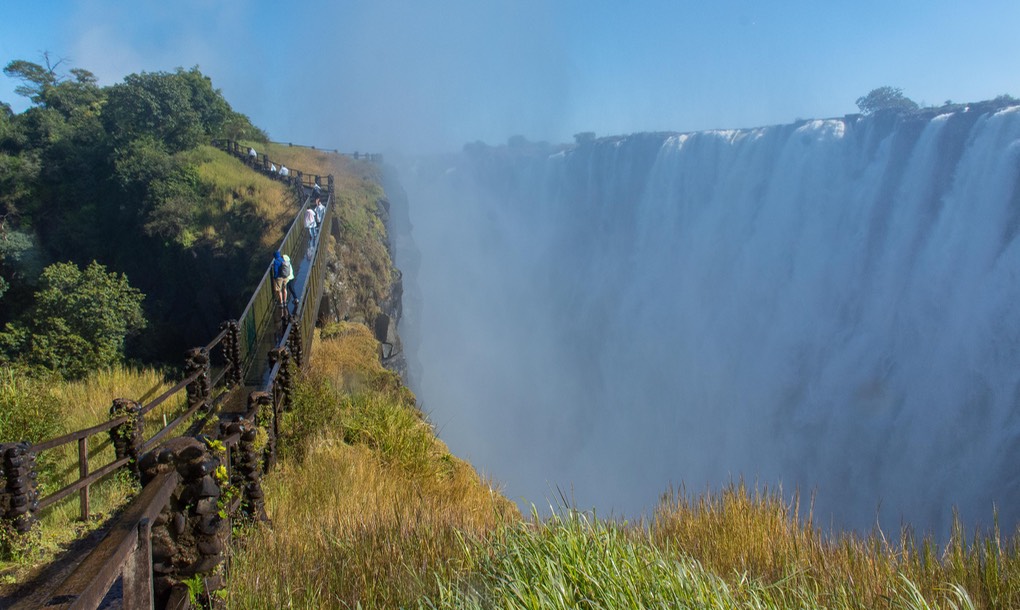
It seems that these days most tourism approaches the Falls from the Zimbabwe side, so it was rather quiet where we were. You can, of course, do both. The easiest thing, it seems, is to park on the Zambian side and view the Falls from there. Then walk to the border (within shouting distance), leave your passport with the officials, and then walk across the large vehicle bridge that links the two sides, enter Zimbabwe, and walk to the viewing areas there. Well, not today. We’ll be spending some time in Zimbabwe later in the year, and if we want to come back to the Falls area, we certainly can.
But for now, onward. We had actually spent a fair amount of time organizing our plans for Zambia by now, and we wanted to get started. We began by driving northeast to Lusaka, the capital. We had found a former Chevy dealer there and made arrangements for a routine service job on the Tiger. And all that went very well.
We also did a lot of grocery shopping, located three different Kubu Crafts stores in the city — eventually even finding the perfect pillow covers! — and organized COMESA insurance for the truck that would cover us in the countries we were heading toward. Now that’s a long, boring story, so feel yourselves well off that we aren’t going to share it! If you like, you can read the fascinating details on our Africa Camping Log page.
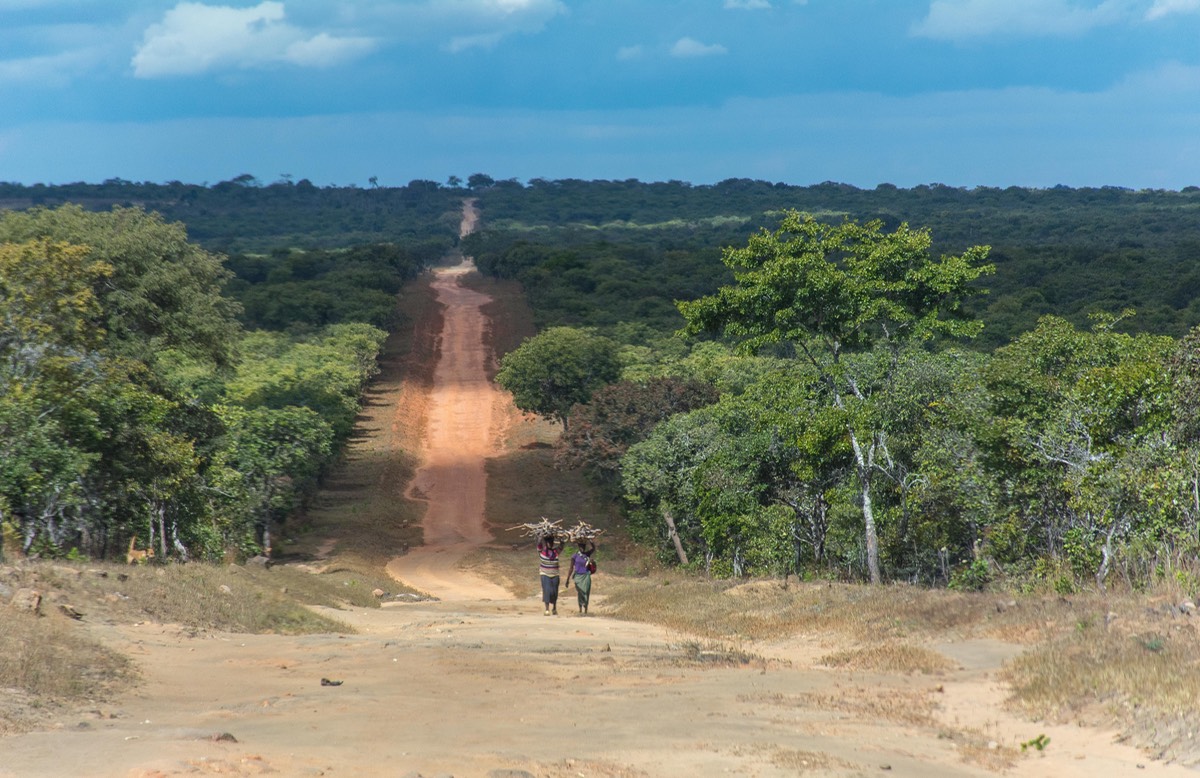
In Lusaka we were staying at a backpacker’s hostel, a nice cozy place right in the city where we felt quite comfortable. And lo and behold (!) on our last day there a biker rode in — with California license plates. We chatted away and found out about each other. Daniel’s from Fresno and has been out on the road for about 2-1/2 years, covering many parts of the world… and has at least as much left to do. Great fellow, and we had a good time together.
Back in Livingston we had made a new, revised plan for Zambia. Early on, we had intended to zip across the southern edge of the country, see Victoria Falls, then quickly cross into Zimbabwe for several weeks before crossing back into Zambia and starting north. But no longer. We’ve decided to leave Zimbabwe until later, and stay in Zambia for the 30 days of our visas. (Nothing like a difficult border crossing to make you leery of immediately heading for another.) We are going to head north and try to see some of the less touristed parts of Zambia instead. There are waterfalls to be enjoyed, a chimpanzee rescue sanctuary to visit, and lots of nice countryside to wander in — we hope.
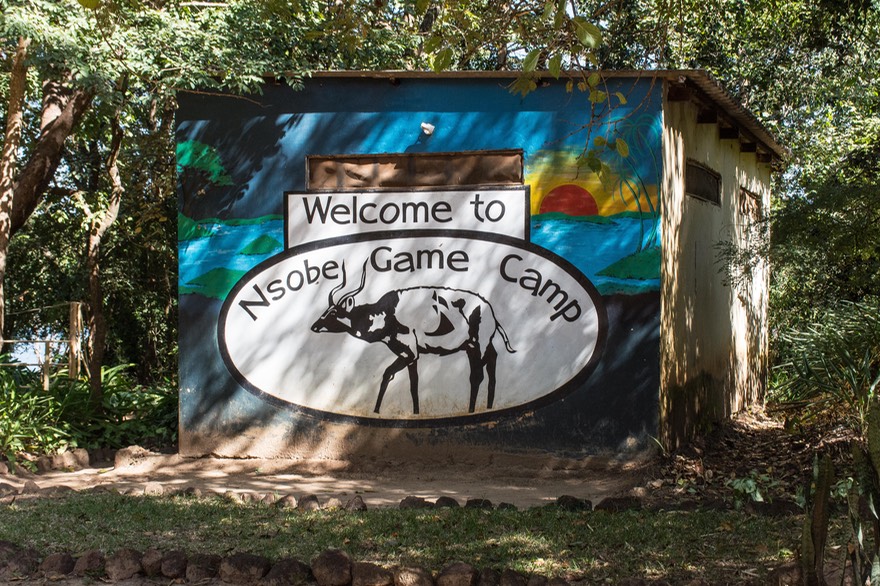
Throughout Zambia, the police check points dog you at every turn. Mostly the officers are in uniform, and they are predominantly male. Very polite, they ask to see your paperwork and sometimes check your license. Occasionally the radar gun has been used, and then you either argue your way out of the fine, or (in one case), give up and pay the damn thing with much retracing of steps to go to the police station and then t the bank and then back… You get the idea. But no screaming and shouting, and always very nice about it all… except in two cases and both times the officer in charge was a woman. We could discuss that with you at length, but you can make your own decisions as to the “why” of that factoid. (We’ve heard that Tanzania won’t be any better, so we’re practicing our smiles and happy chatter.)
Our first stop after leaving Lusaka was at the Nsobe Game Farm, a community-run private game farm and eco-tourism location. It was really quite nice, and very low-key. The camping area is alongside a lake with frisky Vervet monkeys; there are walks and drives to take featuring the gorgeous Black Lechwe antelope; and we were visited by Difassa Waterbuck at our campsite during the early evenings. Both of these antelope types were new for us. Quite a nice place; we were happy to be there and stayed several days. While there we could hear the shouting down at the Reception hut, as Zambia beat Ivory Coast at something involving soccer.
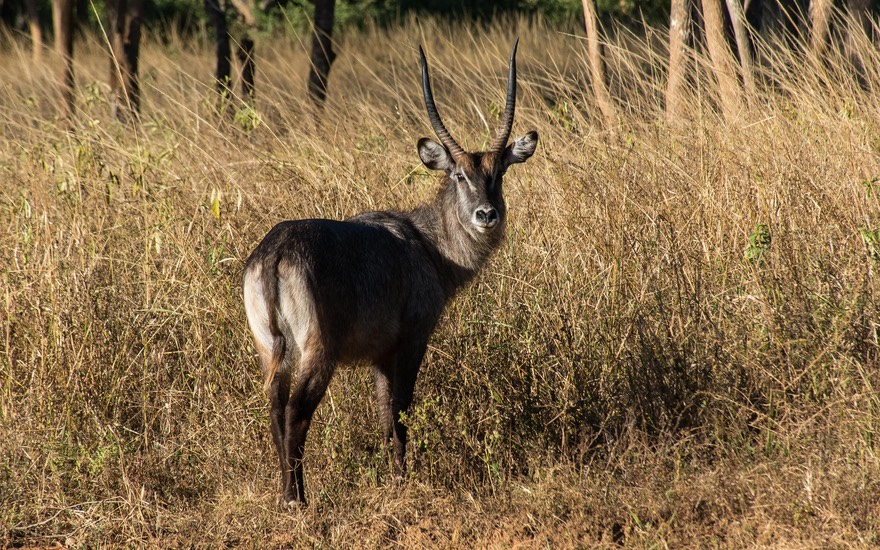
While at Nsobe, we had several discussions about our next destination. We were here in part because it was on the way to the Chimfunshi Wildlife Orphanage. We’d been reading about this great spot and could hardly wait to get there. It’s quite famous for its chimpanzees, for one thing. So, we were preparing to make the trek up towards the DRC border, which sits just beyond the location of the Sanctuary.
Well, not to be. We’d both been sick off and on for more than a week, and were currently dealing with quite crummy colds. We knew it was frowned upon to show up near chimps when you were sick, as apparently they are quite likely to get whatever you bring with you. After 3 days at Nsobe, and not hardly well yet, we knew we’d have to give up on our plans. Frustrated, but knowing we really had no choice, we finally left our lovely Black Lechwes and headed back down to join the main road and head on to destinations further north.
Any old Zambian hands out there? If so, you’re jumping up and down — “Aren’t you going to South Luanga NP? Or to any of the parks in western Zambia? Or, or, or…” Well, no we aren’t. Zambia seems to have caught up with some other African countries in how they choose to deal with tourism — the parks are way too expensive, the vehicles cost tremendous amounts to bring into the parks, etc. etc. So, once again we have to pick and choose where we go and what we see… and how we choose to get there.
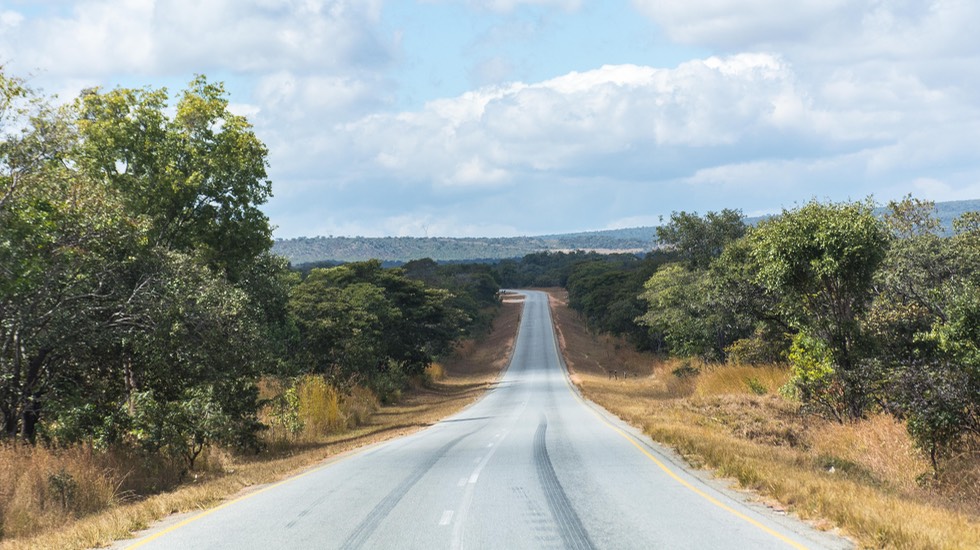
We need to briefly return to discuss the roads in Zambia — where they are, and where they aren’t. To over-simplify, there is one main road across the southern bit (the one we took from Sesheke to Livingstone; from there it leads into Zimbabwe). From Livingston you can go further north, up the Great North Road (the T2), to Lusaka. At the capital there’s one road that heads west into Kafue national park and on to Angola or DRC; otherwise you either go east or continue north. The T3 will take you to South Luanga NP and on to Malawi; continuing north will eventually lead to the Tanzania border and to Dar es Salaam. This road, up-country quite a far piece, has a secondary but tarred road (the M1) that splits off to go through Kasama and lets you explore the northeastern part of the country before entering Tanzania. All this will become clearer as you follow us on a map. You are tracking us, aren’t you?
You see, Zambia has a number of lovely/stupendous/magnificent waterfalls that are in parks that are less expensive than the “biggies”, and we’ve decided on a route that will take us up to the Tanzanian border through the less often visited northern Zambian area and which will drop us off at a reportedly good, supposedly quiet border crossing into Tanzania. But what about the low rainfall you might ask? Won’t the waterfalls be disappointing? Good of you to ask. Interestingly, north of Lusaka they’ve had a great rainy season. Little rain in the south and in Botswana and Namibia, but near historic amounts where we were heading, and into Tanzania as well. Climate change anyone? So the waterfall circuit in northern Zambia was looking pretty good to us.
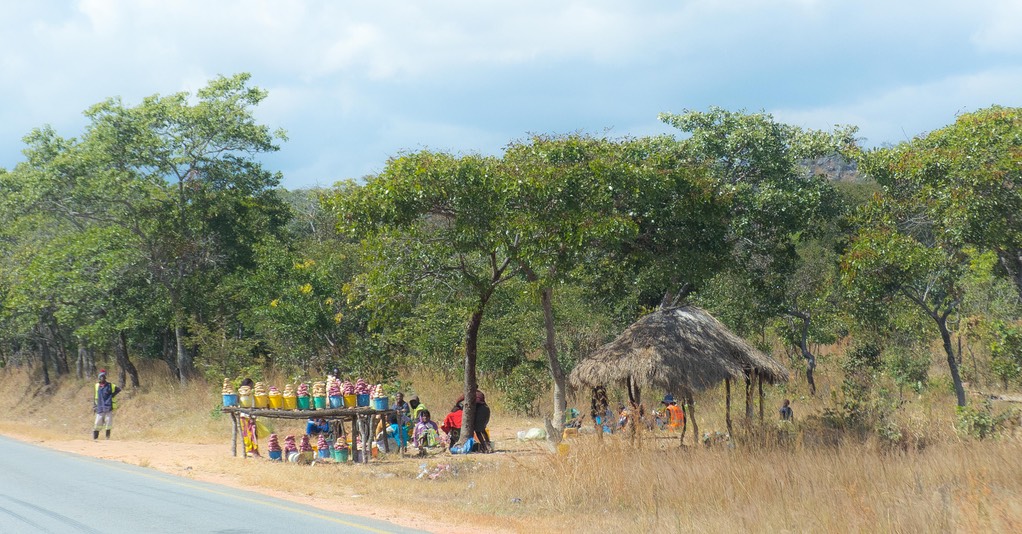
We worked our way north through Mkushi River towards Mpika. Where there are fields, they have already been cleared — the hay and corn and garden crops are in. Street markets are filled with tomatoes and cucumbers and potatoes and root vegetables. This is a very productive area. Charcoal, packaged for easy sale, lines the roads. We are now seeing cows doing double duty as they pull the small carts used to haul stuff to market and away. Soon we start seeing sugar cane stalks piled along the roadway, and folks chewing their way through the afternoon.
A small digression on the subject of charcoal. It’s quite a huge industry here in Zambia. I’ve just now been reading about charcoal production in Malawi, and the two countries seem alike on the subject. In Malawi production is illegal (and we suspect the same is probably true in Zambia), although in both countries the illegality appears to be mostly ignored, and certainly not prosecuted. Here in Zambia, whole mountainsides are having their trees cut down, either for firewood directly, or to be processed into charcoal. The problem, of course, is that replacement trees have not been planted. Ecologically, it is a disaster, and it is distressing. In Malawi they are taking some action, and we hope Zambia will follow. More on the Malawi side later.
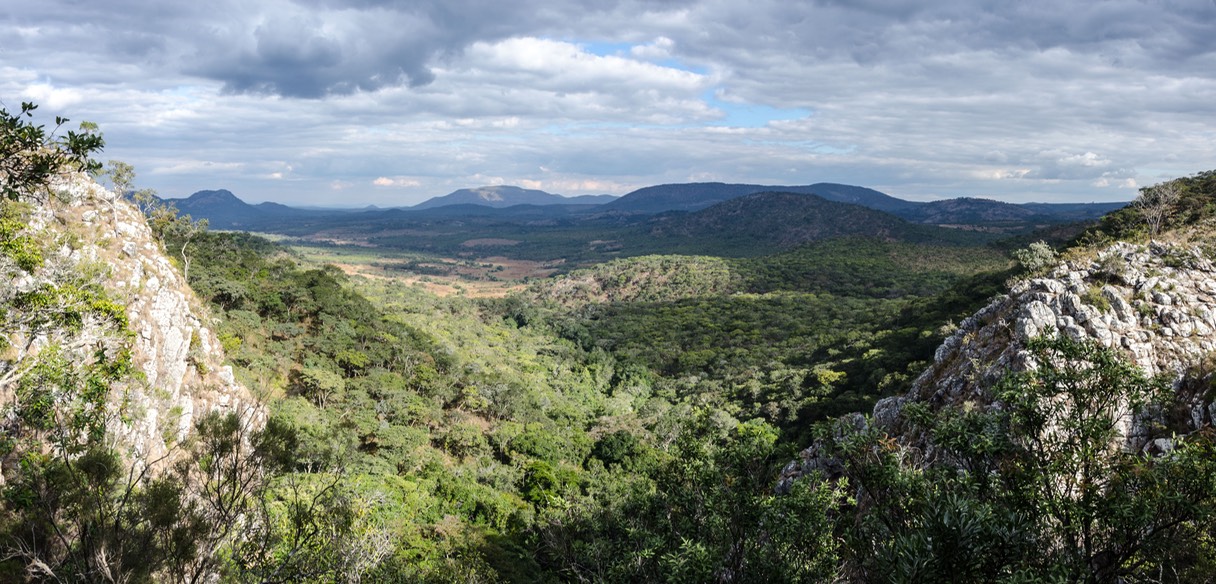
We stopped first at the Kundalila Falls. Most people do, and they often complain about both the lack of facilities at the campground, and the outlandish price being charged. But we’d seen some lovely pictures of the falls and thought we’d give it a try. All is as reported, and we should have done our homework better. The beautiful photos are taken from the bottom of the falls, and the path down was long and arduous and beyond the abilities of our deteriorating bodies. However, and this is the good part — the view out over the valley from the lookout at the top is just marvelous. It can be difficult for us to get somewhere with beautiful views; this was terrific. So? Glad we came.
It’s getting colder at night now (mid-June), and chilly during the day if the sun isn’t out. We decided to go and visit the Mutinondo Wilderness area. The park has some quite striking hills we’ve seen pictures of, and they looked interesting. As it turns out, we discovered a listing for a wilderness wild campsite close to the park entrance. We stopped and were delighted with the views to be enjoyed right there; ended up staying a couple of days before moving on. Never did get into the park!
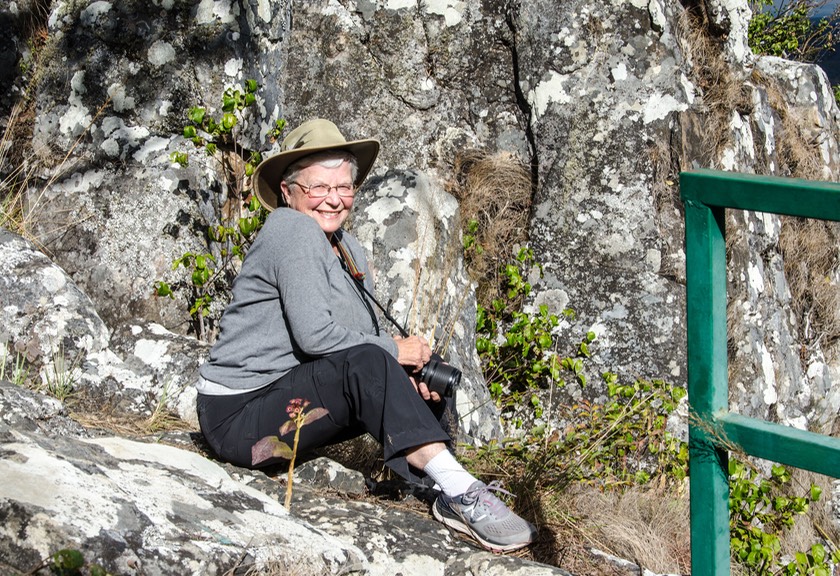
In Mpika we made sure to fill our tanks; reportedly it might get more difficult as we move on up the hill. We pulled into the parking lot of the local hospital for a quiet lunch in the truck, and found we had internet. Goody! It’s been a few days. Mpika is where the split is; here you make the decision whether you are continuing up the T2 highway to the border crossing at Tunduma (major road with major really nasty sections, and tons of truck traffic heading to and from Dar es Salaam), or taking the M1 highway north through Kasama and towards a bunch of those waterfalls we’re thinking about. We confirmed with ourselves that Kasama was the route of choice, and plunged ahead.
We encountered a large roadworks project; all the trucks were of a Chinese make, and that was the language on their sides. Looks like they’re doing a good job. Probably totally unrelated, we’re also seeing cell phone towers and solar panels a lot. And electricity is coming to the area. We wonder what else might be afoot.
Reaching Kasama, we stopped at the Thorn Tree Guesthouse. Hmmm, you say. They stayed at the Thorn Tree House in Livingstone. Yup, same family. Also a nice place. Good spot for chilling out, if you can get underneath the arbor at the entry. Go Tiger! In and settled. A pretty tight spot, but very nice nonetheless; and a lovely chicken curry for dinner!
We are seeing very few totally isolated areas as we move along the highway. There are groups of dwellings every few kilometers. And these people are working hard. As we drive, we pass bicycles loaded down like you wouldn’t believe. The bike is the high standard in Zambia in the rural parts of the country. They will often have three people on a bike. Or up to four huge sacks of charcoal or a big load of firewood being balanced precariously by a man walking alongside.
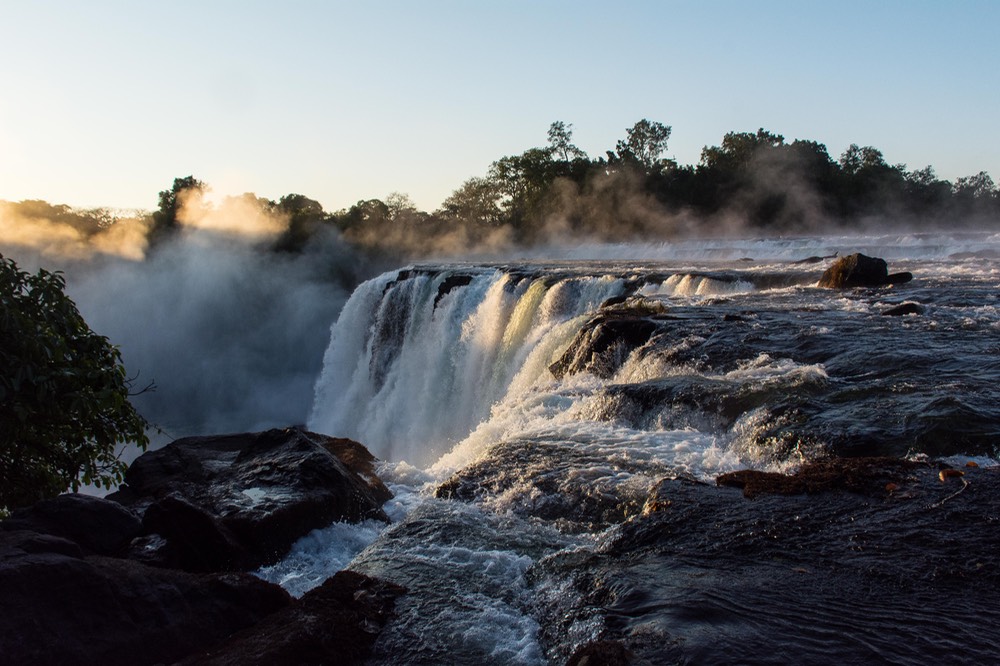
There are few “local” cars; lots of people walking long distances; children, when they are big enough to use their own feet, often will have bundles they are trundling along with. Small children leading smaller children by the hand. No fighting or pushing or running. It seems the children are taught very early to respect the road and always be careful.
From our resting spot in Kasama we went west (a very long way west!) to see the waterfalls in the Lusenga Plain National Park. Much of this was on good roads, including a quite new section. Then we dropped onto dirt, and went to Road Hell. Perhaps a slight exaggeration (no it’s not!), but we’re seeing more and more dirt roads in rural areas that are really, really bad. Deep ruts left from rainy seasons past, many deep potholes and large rocks sticking up here and there. Challenging to be sure, and very slow progress.
But we survived, and the waterfalls were absolutely the best we’ve seen in Africa; much more special than Vic Falls. We saw the Kabweluma and Lumangwa Falls; if you’re looking at your map, they both flow out of the Kalungwishi River . We spent two nights parked right next to the falls, first on one side and then the other; they are huge, with long, noisy drops into pools, and simply wonderful. Mist in the mornings; more water than you can calculate — as noted, northern Zambia has had plenty of rain this year and the falls are huge. It was so great; suddenly I felt as if I’d actually found the real Africa. I could sense what the great explorers must have felt when they came on these huge bodies of water. It was almost like exploring with Speke, or Burton, or maybe even Livingstone himself. A great feeling.
After all the splendor, we got back on that road from hell, went 90 kms to Mporokoso — it took 4 hours — then picked up pavement and zipped on back to Kasama. We felt so, so good about this adventure!
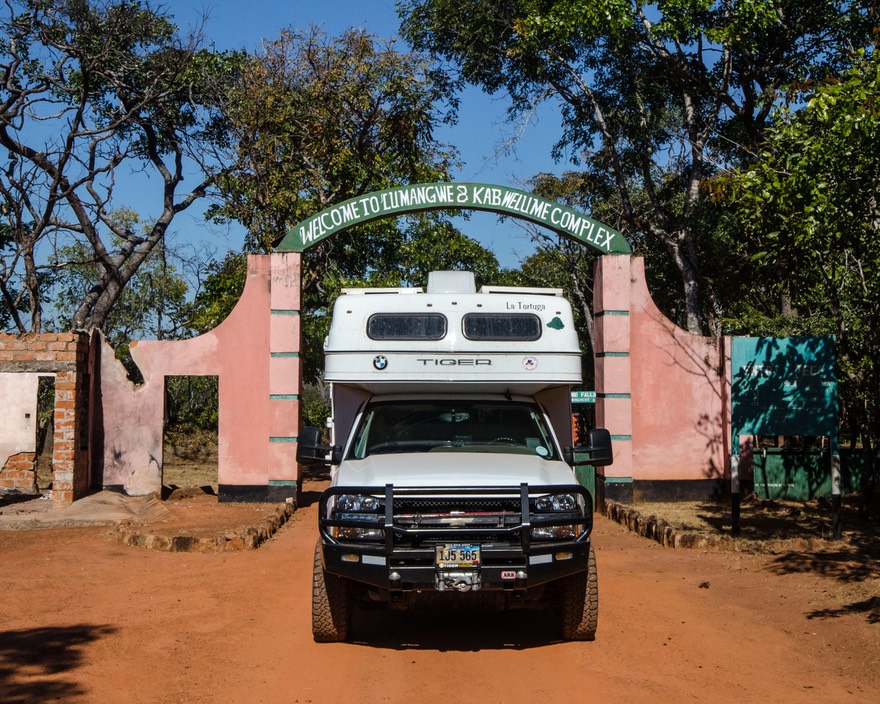
A small digression. Rick says we are traveling faster than the sun — or something. A question in his mind had been the relationship between our position and that of the sun. If, in the southern hemisphere, in June, you are moving north, and the days are getting shorter, is the sun going to come up later each morning — or not? Well! Profound! In our case at least, we are moving north more quickly than the sun is coming up later. (Got that?) So… the sun is still coming up earlier each morning. How ‘bout that!
We arrived at the smallish town of Mbala, near the border. We got here almost at dark, so we didn’t see any of the surrounding area, but it has been described as being right on the edge of the Great Rift Valley. We have settled in to a nice Lodge on the edge of a small lake. It is a retreat and conference center, along with being a recommended stop-over while preparing to cross the Tanzanian border, some twenty-five kilometers up the road.
That evening, poor Rick started having gastrointestinal problems. While he worked on recovering, we worked on our plans for exploring Tanzania. After a couple of days he was feeling somewhat better so we started north out of Mbala…
Well, as so often happens, the fates intruded themselves into our plans and when that happens it is usually the plans that must change to accommodate the new realities. Such was the case on the road north from Mbala. As we struggled along over the difficult road, we talked about our plans for further north.
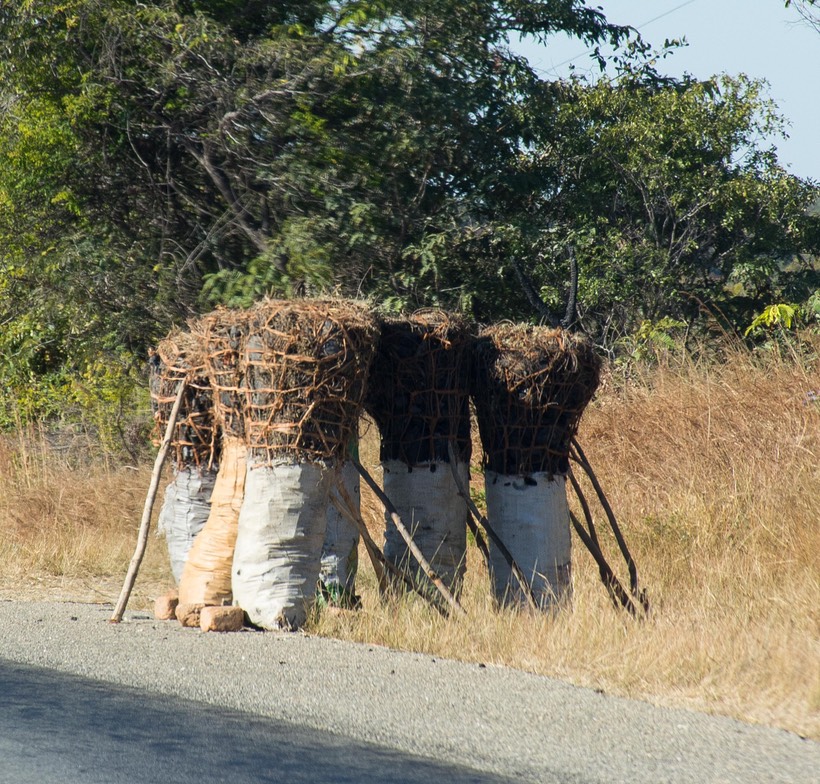
After crossing into Tanzania, we were planning to work north along the shores of Lake Tanganyika and make a circumnavigation of Lake Victoria, which would take us to Burundi, Rwanda and Uganda and then on into Kenya. Turning south again from the Nairobi area, we wanted to see more of Tanzania on our way down to Malawi and Zimbabwe before eventually ending up back down in South Africa, from whence all this adventuring began.
The new realities we encountered this morning were actually not all new, they just sort of ganged up on us in a way that we could no longer ignore.
First off were the road conditions. All of our traveling contacts had warned us that the roads would be even more difficult further north. We generally take that sort of advice with something of a grain of salt because we are perhaps more accepting of bad roads than some others; we are at the least always willing to give it a shot, to Keep Buggering On so to speak, and not worry too much about what the roads are like. This serves us well up to a point, but the road heading toward the border crossed over that point for us. Our wonderful Tiger has many strengths, but his main limitation for rough road travel is ultimately his limited ground clearance; and this is where we found ourselves running into difficulties. As described earlier, the deep ruts and potholes combined with large rocks protruding from the road surface made for conditions that had Tiger scraping his underbelly all too often. Rick simply couldn’t always find a path around the obstacles.
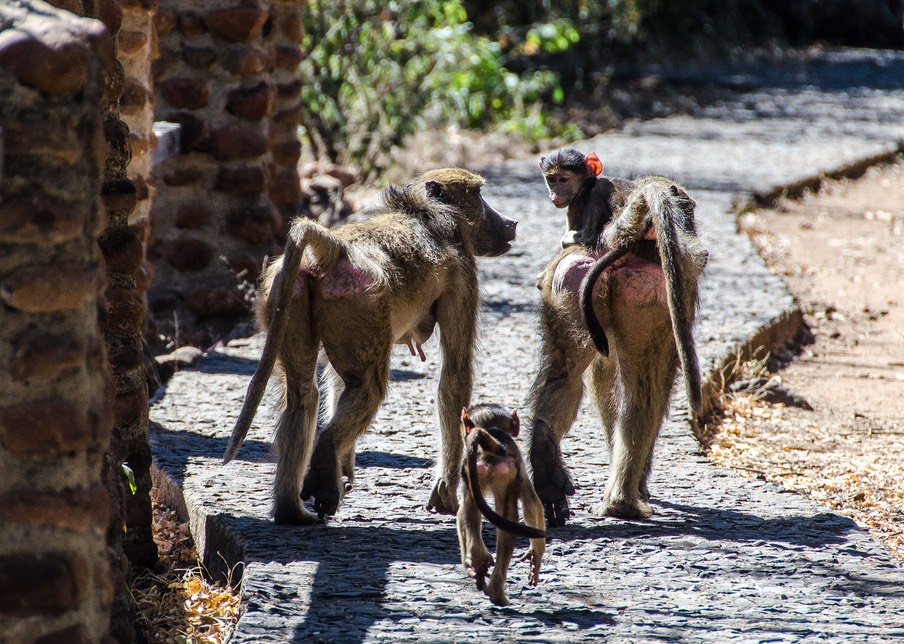
Second problem was that the Tiger had a mechanical issue that had been nagging at us. This was a coolant leak that we’d been dealing with since our return to Africa back in February. We’d had it looked at a couple of times, most recently in Lusaka two weeks before. Rather than getting better the repair attempts had indeed made it worse, and we’d had to stop at the side of the road a few days earlier while Rick worked on the problem to allow us to keep going.
Our third and last issue had to do with Rick not feeling 100% healthy and also dealing with a painful knee. Not to dwell on these issues, but we all understand that things become more difficult when we are not ourselves at full strength.
Taken all together, we simply stopped in the middle of the road as we contemplated a pile of rocks ahead of us, and agreed that at the present moment, we were just not having any fun. First maxim of Team Tortuga: If it stops being fun, do something different. So we did. We turned around.
Having driven as far north as the latitude of S 08.76563, we said “That’s it; that’s as far north as we are going”, and changed our plans. Still on to Tanzania, but by a different path that would take us more directly on to Malawi and Zimbabwe. So be it.
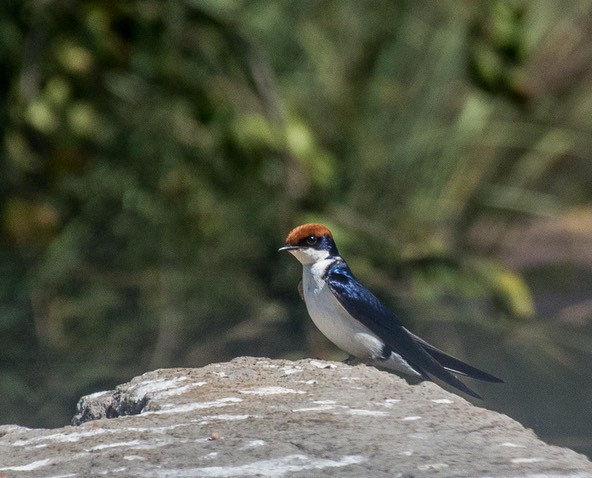
Some final thoughts on our time in Zambia. We spent a bit more than 3 weeks here, and it depends on who’s talking as to whether we had a good time or not. Rick does all the driving (doesn’t trust me behind the wheel in foreign countries), and the roads really beat him up, as you can tell. He’s also responsible for worrying about the Tiger; and he does. I, on the other hand, get to look at all the activity going on around me, enjoy the grins and waves of the little children beside the road, chat with the women selling me tomatoes (“no, no broccoli, he won’t eat it” — which always gets a grin in response), and enjoy the changes in the faces I see as we drive along. You just get to a point where you think you can identify the facial characteristics of the people of a country, and then suddenly they change as you move into a different area. Quite fascinating.
It’s all good; I love being in Africa — whatever country we are in — and I think Rick does, too, but perhaps not quite so much. We’ll fill you in next time on what happens as we turn a corner and head in a new direction.
Hugs and kisses from the slightly limping Team Tortuga — Rick, Kathy and our ever faithful steed, La Tortuga
See more from Zambia on the photo page for this story